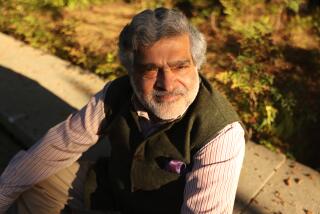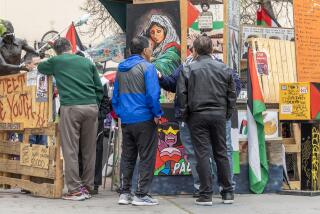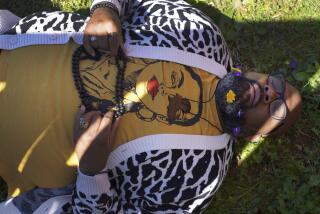Dalai Lama’s Disciples Gather for Peace Prayer : Religion: About 150,000 participate in ceremony with the Peace Prize winner.
SARNATH, India — Carol Corradi sat cross-legged, her eyes closed to the North Indian dust clouds and the 150,000 other disciples packed around her in this holy city of the ancients, as Buddhist monks intoned a complex prayer for peace.
Seated on a stage before her, draped in robes of gold and maroon, the Tibetan monks were helping initiate Corradi and the other devotees in the Kalachakra, a four-day prayer of purification and empowerment that the faithful believe was first taught by the Buddha 25 centuries ago, as his kingdom was poised on the brink of an apocalyptic war.
In the center of the monks, seated on a platform high above an outdoor stage, was the 20th-Century teacher of that message of peace, the Dalai Lama, revered by his followers as the 14th incarnation of Buddha’s wisdom.
This was New Year’s Eve in Sarnath, a city of ruins and remembrances where archeologists believe that Buddha taught his first lessons in 600 BC.
And, with the world again poised on the brink of war, the winner of the 1989 Nobel Peace Prize summoned his inner circle of monks and devotees from two dozen countries for one of the most sacred of ancient Buddhist rites. There were about 1,000 Westerners, who had traveled as far as 10,000 miles to join with tens of thousands of Nepalis, Indians, Mongolians, exiled Tibetans and other Central Asian Buddhist pilgrims in absorbing the teachings of the Dalai Lama.
Corradi, 37, is an astronomical engineer at Lawrence Livermore Laboratory in California and is helping design the super-conducting super-collider, which scientists hope will re-create the Big Bang theory of the universe’s creation.
“For me, whatever I get here, I take back to the West,” she said. “It helps me relate the teachings to my life. I’ve found that it meshes very well with the scientific side of what is happening.
“But there are many things in the Kalachakra having to do with peace as well and imparting this message of peace to others. And, of course, these are dark times.”
Standing beside the stage where the Dalai Lama was, in his words, “planting the seeds” for enlightenment and world peace, was a 46-year-old native of Paterson, N.J. Dr. Alexander Berzin, whose Harvard doctorate in Far Eastern languages 20 years ago led him to the Dalai Lama’s northern India headquarters-in-exile of Dharamsala, has served as archivist and part-time translator for the Dalai Lama ever since.
In the process, he has become an international expert in bridging the mystical world of the East with the language and pragmatism of the West.
“Kalachakra literally means Wheel of Time, and it’s best to think of it as one of many different encyclopedic bodies of knowledge and teaching,” he said, as the Dalai Lama and his monks began chanting verse-by-verse in Tibetan.
“It includes astronomy, physics, medicine, astrology as well as the spiritual teachings. It’s basically a gathering to enable people to have the causes for practicing this system of meditation and, on a more mundane level, to bring all of these people together to generate the causes for peace in the world.”
Clearly, the Dalai Lama, who last taught the Kalachakra a year ago at an auditorium in Los Angeles, meant the prolonged meditation prayer to be a powerful message of peace to the outside world.
In a speech he delivered to a group of Indian intellectuals in Varanasi before he began the Kalachakra early Saturday, the Dalai Lama said: “Many people shout, ‘How bad, Saddam Hussein? How bad, the invasion of Kuwait?’ Of course, it is very bad,” he said.
But the Dalai Lama quickly added that human nature in general has been sliding rapidly into a dark age of violence and destruction.
“That atmosphere spoiled Saddam Hussein. He got an army. He got equipment. He felt that he was the most powerful, that he could do anything. The deeper cause of this present crisis is the weapons. What did his country produce? Weapons.”
Adding that much of Iraq’s military machine was imported from Western Europe and America, the Dalai Lama concluded: “These countries have equal responsibility for the present crisis. . . . That is the situation and it is very sad.”
The Dalai Lama’s personal secretary, Chhime Rigzing, said that the Dalai Lama had written a message to both President Bush and Iraqi President Hussein, in which he stressed that “peace is not just the absence of war or a peace borne out of mutual fear. Real peace is one of compassion and the absence of hate.
“But it is not only the gulf crisis,” Rigzing said. “Even in India there are so many problems.”
Indeed, religious hatred and violence have contributed heavily to the official 1990 toll of 7,197 deaths from violent clashes between Hindus and Muslims in Northern India.
Another corner of darkness that the Dalai Lama addressed was the one that was perhaps the most intensely personal.
It was the simple fact that, among the disciples who gathered in Sarnath, were tens of thousands from his own homeland. Like him, they have lived in exile since 1959 when China took control of Tibet.
So great was the draw of the Dalai Lama’s Kalachakra rites that thousands more Tibetans illegally crossed the Chinese border into Nepal, then trekked on foot south to Varanasi and Sarnath just to hear his teachings.
Some of them didn’t make it. Tibetan pilgrims told tales of Chinese and Nepali troops beating, robbing and killing pilgrims as they attempted to cross the border.
Addressing the Tibetan disciples at the ceremony, the Dalai Lama reiterated his commitment to a nonviolent struggle against Beijing.
To reinforce his message, the Dalai Lama distributed hundreds of thousands of fruit-tree seeds. He instructed his disciples to take them home and plant them as symbols of hope and peace.
BACKGROUND
The Kalachakra is a four-day prayer of purification and empowerment. Devout Buddhists believe it was first taught by the Buddha himself 2,500 years ago to ward off evil. The prayer includes a prediction that, in AD 2424, barbaric forces will try to destroy the world. But Buddha’s kingdom will overcome the evil, the legend says, ushering in a Golden Age.
More to Read
Sign up for Essential California
The most important California stories and recommendations in your inbox every morning.
You may occasionally receive promotional content from the Los Angeles Times.









